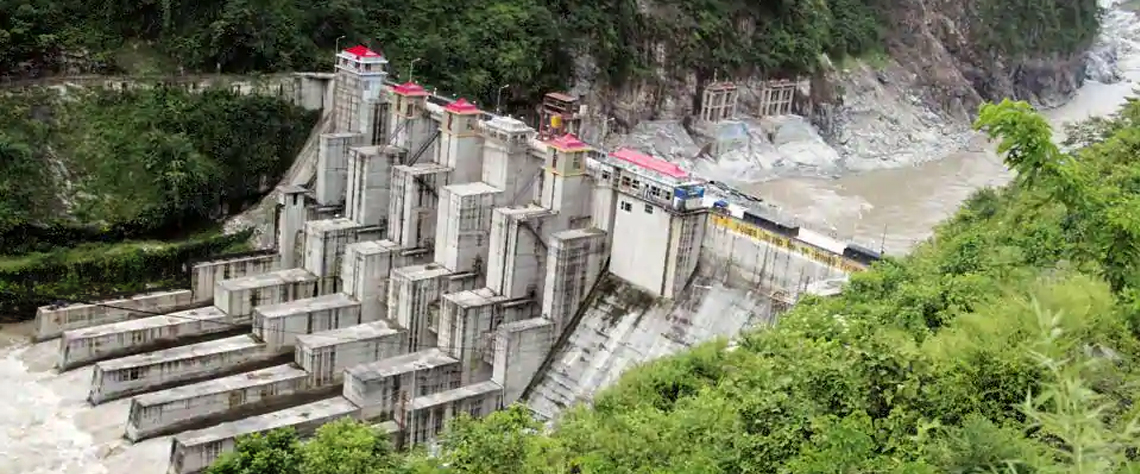
Can India Achieve Sustained Fast Growth? The Two Faces of Indian Capitalism
In the last few years, India seemed to have achieved the symbolic goal of growing faster than China (at least according to official statistics) and was frequently hailed as the fastest-growing large economy in the world (Figure 1). The Spring 2019 IMF World Economic Outlook forecast continued optimistic prospects, with a slight acceleration in growth to 7.5% by 2020, even as China and the advanced economies are projected to decelerate.
Figure 1: India overtakes China in the growth stakes
Source: World Bank
Is India’s fast growth sustainable? Recent economic data indicates declining consumption, anaemic private investment, diminished corporate performance, agricultural distress and slowing GDP growth. (Questions have also been raised over the statistical robustness of recent growth.) Rathin Roy, of the Prime Minister’s Economic Advisory Council, has raised the issue of structural problems leading to a ‘middle income trap’, linked to inequality and associated failures in productive employment growth.1 The 2018 Economic Survey also referred to the challenges of productive transformation, human capital and agricultural distress.2
India’s economy holds great potential, but there is a big risk that this will not be translated into reality. Relative to its income level, India has both a highly diversified economy and well-developed organizational capabilities in the business sector. These presage multiple opportunities to upgrade, reinforcing classic forces for ‘convergence’ as the country catches up with those at the technological frontier. These forces are complemented by the (potential) demographic dividend as young cohorts enter the labour force.
However, on current trends, India is en route to the Latin American path, in which episodes of fast growth tend to stall in the long run. Signs of Latin Americanization lie in the consolidation of what has been referred to as ‘oligarchic capitalism’, with its drawbacks of widespread informalization, rising extremes of inequality, and a corporate-financial nexus of bad assets that risks growth and macroeconomic stability.
Our interpretation of a middle income trap in this paper is an essentially political-institutional account, embedded in the nature of the relationship between the state and business and between the state and society. Indian capitalism has two faces: dynamic, competitive and productivity-oriented; and connected, rent-extracting and corrosive politics. Some sectors and companies are more ‘rent-extracting’ than others. But many face both ways. Large Indian companies – such as the Reliance and Adani groups – seem to have both high productivity and high levels of influence. Then, beyond the corporate business sector, there are immense numbers of self-employed, small and medium-sized firms in the informal sector.
These features resonate vividly with characteristics of Latin America capitalism. This can be seen as having three types of enterprise: connected plutocrats with major influence over the state system (such as Carlos Slim in Mexico, and other Mexican billionaires), the rest of the business sector (that struggles with regulation, poor infrastructure and weak skill development), and a very large number of small-scale/informal enterprises (with weak access to formal credit, legal recourse, infrastructure and modern productive support systems). Countries such as Mexico and Brazil had their episodes of fast growth and then got stuck in a mix of low productivity, inefficient social policy, and periodic macroeconomic crisis.
As in Mexico or Brazil, capitalism in India operates in a system that is characterized by both formal rules and less formal deals. ‘Deals’ refer to both broad understandings and particularistic relations between the state and business. But ‘rules’ also matter. Rules can be in tension with deals when the latter aim to subvert the former, but hybrid arrangements – such as when rules are applied in the implementation of deals – are common. Carlos Slim got his big break through the (legal) privatization of Mexico’s telecom company by the then president, Carlos Salinas. Most of Mexico’s other billionaires were also launched then. And this was when Mexico was already significantly richer than India today.
Rules matter when implemented well; they play the essential role of providing credible threats and penalties for unlawful deal-making, in addition to dealing with the array of concerns over standards, safety and protection. But an over-regulated, rule-based economy can crowd out investment and stymie growth. India’s economy has evolved from being a case study in over-regulation to, functionally, a hybrid of rules and deals. Of the business-politics nexus, it can be said that ‘the relationship can no longer be understood as either developmental or crony capitalist: it is both’.3
India’s major growth acceleration occurred in the 2000s. It involved a striking growth in aggregate – and, in particular, private – investment and exports. Both faces of capitalism were manifest. There were significant strides in business capabilities and capitalist institutions. However, even as GDP skyrocketed, India’s growth story was dogged by concerns over high-level corruption and rising inequality. A series of scams over natural resource allocation helped consolidate public anger around entrenched politician-business links, spurring a national anti-corruption movement. An elite coterie of Indians was seen to be pulling the strings of politics and business, and public sentiment rallied around these societal shifts.
While household surveys suggest inequalities are still much lower in India compared to Latin America, there is evidence of continued concentration of wealth and incomes at the top of the distribution. Combining tax data with household survey data, Chancel and Piketty estimate a large increase in the income share of the top 1%, matched by a corresponding decline in the share of the bottom half of the population (Figure 2).4 By this measure, the difference in income growth between the top and the rest of the distribution was even greater than in China and the US – both notorious for their inequality rise (Table 1).
Figure 2: The rising concentration of income in India
Table 1:
A more specific manifestation of growing inequality is the rise in wealth of India’s billionaires, almost all of which is fuelled by business success (Figure 3).
Figure 3: The wealth of India’s top ten billionaires rose rapidly between 2014 and 2018
Source: Forbes.com
A crucial heritage of the period of heady growth has been a dramatic rise in reported non-performing assets (NPAs) in the banking system. NPAs are products, at least in part, of past state-business links, especially between public sector banks and influential businesses. NPAs were over 14% of gross advances in 2018 for public sector banks, with a still-high 8% for net NPAs (net NPAs are net of provisions) (Figure 4).
Figure 4: A large rise in Non-Performing Assets, especially in public sector banks
Source: DBIE, RBI
This rise in NPAs, alongside recent setbacks to India’s shadow banking industry, is a crucial constraint to the flow of credit and private investment, which has stalled in recent years. Gross capital formation as a percentage of GDP is hovering around 31%, its lowest since 2003 (Figure 5). Reported new investment proposals have also been falling steadily since 2015 (Figure 6).
Figure 5: The rise and fall of India’s investment rate
Source: World Bank information base
Figure 6: The rise and fall in investment proposals
Source: CMIE
Resolving the NPA crisis, an increasingly important policy priority in recent years, is necessary but not sufficient. The informal sector continues to dominate the economy, with over 80% of non-agricultural workers employed by the informal sector and Micro, Small, and Medium Enterprises (MSMEs) contributing over a third of GDP. Yet the IFC estimates that formal credit channels account for only 16% of debt financing in the MSME sector.
The Urgency of Action
Why is a focus on the functioning of Indian capitalism so important for the incoming administration?
For every administration that fails to put in place the institutional and policy preconditions for dynamic, inclusive development, there is a permanent loss in productive and human potential. Failure to act now means another cohort of India’s youth being substantially ill equipped to participate in productive work, fostering further increases in inequality.
Even more critical is the risk of further entrenchment of business elites, with respect to their links to both the state and minority shareholders, creating an oligarchic capitalism that heightens resistance to future institutional transitions to dynamic, competitive capitalism.
Furthermore, the global economic context is much more anaemic than the ‘sweet spot’ of the early 2000s. Long-term growth is slowing throughout Europe and the US. Even China – the main autonomous source of growth in the global economy – is in the midst of both a long-term slowdown as its economy matures, and concerns over financial fragility.
Finally, global technological change will increase incentives for increased automation in the economy. This is likely to have profound effects on the work opportunities for India’s labour force, with as yet ill-understood consequences.
These developments will have major distributional dimensions that threaten political stability. The interaction between a consolidation of oligarchic capitalism and the less favourable global context is why the risk of a Latin American style middle income trap is so salient.
A Policy Agenda
Whether India realizes its growth potential or gets stuck in a middle income trap depends on both policy choice and institutional design. Avoiding the Latin American path of oligarchic capitalism and widespread informality involves building the basis for a dynamic, inclusive and competitive capitalism. This requires, in the resonant phrase of Raghuram Rajan and Luigi Zingales, ‘saving capitalism from the capitalists’.5 Rebuilding state-business relations in an open, competitive rules-based fashion is essential. We outline six complementary areas. The complementarity is critical, as is an overarching theme that without institutional deepening with respect to accountability, autonomy and transparency, these policies will be subverted.
(1) Resolution of NPAs: Critical to real credit flows, investor sentiment and the broader macroeconomic health of the system is the effective resolution of NPAs. While the Insolvency and Bankruptcy Code (IBC) has set out a sound framework to resolve NPAs and shift power from promoters to creditors, translating the promise of the IBC into practice remains a challenge. RBI data available until January 2019 indicates that resolution has been approved in 66 cases so far, unlocking INR 800 billion for creditors. But the pace of resolution lags the Act’s guidelines – egregiously, in some cases. In addition, continued vigilance is required to ensure that tight eligibility guidelines for potential buyers do not translate to increased corporate concentration in key sectors. Underpinning the broader NPA challenge is the need to sustain the autonomy of the central bank, whose independence must be protected and unchallenged by the executive.
(2) Competition: Dynamism and innovation require competition. Many sectors are already concentrated, and there are risks of further concentration – in the consolidation following resolution, and in the future via network effects in platform-based sectors. This is vividly illustrated by the debates in Europe and the US over platform-based companies. This requires an empowered, autonomous competition authority, and also continued innovations in regulation in the wake of technological change. Mexico actually created a strong, autonomous competition authority, with a dynamic head who could not be removed by the executive. But its action on anti-competitive behaviour (including of billionaire-linked companies) got stuck in the judiciary – with lessons for India. Infrastructure and natural resources are a special case: while auctions are an important step, implementation is again crucial. The most notorious Latin America-wide corruption scandal of the recent past, involving the Brazilian conglomerate Odebrecht, involved a series of contracts won in competitive auctions for PPPs. The Achilles heel was in the renegotiation phase, when concessionaires often extract big advantages. An alternative design is to make renegotiation also subject to credible, third-party scrutiny and decision-making with transparent processes.
(3) Better rules: Shifting the balance to rules-based interactions requires better rules. There has been a plausible focus on the ‘Doing Business’ indicators and healthy interstate competition on the rankings. However, international evidence finds that these notional measures are often completely unrelated to actual experience, which depends on implementation. The GST reform should help in the long term, but the costs of participation often still seem to outweigh the benefits, especially for informal firms. Of specific importance are the complex areas of land acquisition and labour policy. While there has been a tendency amongst economists to fetishize labour flexibilization as the missing ingredient for labour-intensive industrialization (it is no panacea), the goal has to be delinking social protection from the labour contract if inefficient informalization is to be discouraged; this is a specific bridge to comprehensive social policies.
(4) Facilitating implementation: The bureaucracy has in the past been in the production line of converting politican-business deals into the prevailing rules. With the (desirable) anti-corruption motif, there is widespread reference to the ‘chilling’ effects on approval, from both business and bureaucrats. Some reduction in the excessive legal risks for bureaucrats have come with changes in the 13(1)(d) regulation in 2018 – which previously criminalized bureaucrats for any loss to the government, even if there was no intent – but the effects are still unclear. Additional action, such as new third-party processes for contract renegotiation just referred to, can help. This is an area where concerted exploration of implementation design is important.
(5) Inclusion: Deepening institutional support for small-scale and informal enterprises will require a whole suite of policy changes across sectors and along the value chain. Providing more robust support to MSMEs, including those in rural areas, will require enhanced infrastructure provision (along the lines of the Pradhan Mantri Gram Sadak Yojana), a deepening of financial inclusion and access to credit, a data-driven reorientation of NRLM and urban skilling programmes, and finally, a revamping of CSR towards leveraging corporate comparative advantage in favour of supporting business enterprises instead of government programmes.
(6) Industrial policy: Finally, there is a potentially important role for sector-specific industrial policy. In this regard, India has both successes and failures. The auto industry has benefited from a series of state actions that led to a productive sector strongly integrated with global value chains, notably in Tamil Nadu. Sector-specific public goods, such as on National Automotive Testing and R&D Infrastructure Project, are also examples of successes. By contrast the Special Economic Zone policy often became associated with land deals. Effective 21st century industrial strategies require both close cooperation with the business sector and a focus on sector-specific public goods (rather than a bias towards protection or tax breaks), but also sufficient autonomy from business lobbies – or especially a politician-business nexus – to avoid consolidation of inefficiency and rent-extraction. Credible sunset clauses to support are one example of an instrument.
This is only an outline of policy domains. While the complementarity between them is vital, even more important is the way in which the state behaves in their implementation. And key to this are the checks and balances that lie at the heart of the accountability mechanisms that underpin state behaviour.
These are of two complementary kinds. First, there are checks and balances within the state: fundamentally in the independence of the judiciary, but also the full array of regulatory agencies, and the incentives that they face. India has had plenty of experience of accountability institutions, notably in the long-term independence of the Election Commission and the Supreme Court. Both, however, are increasingly seen as subject to influence, with critical actors in both taking unprecedentedly public measures to decry perceived threats to institutional autonomy and conduct.
Second, there is the pressure from civil society, whether (weakly and imperfectly) via periodic elections, or through ongoing civil society activism over state performance, via many mechanisms. This is heavily influenced by the availability of information, for which the various kinds of media play a central role. Unfortunately, the traditional media in India is largely owned by big business, and mostly supine on state business concerns.
There is room to strengthen both the mechanisms of accountability that belong with the state, and those that belong with civil society. What is needed is a genuine counterbalance in institutional and societal terms, complemented by strengthening, not weakening, of the capabilities of the state. For while India has a tradition of very high-quality individual state actors and a reputation for an overbearing state presence, a real issue is weaknesses in state functionality.
The Latin American experience shows that growth can occur for a while under conditions of oligarchic capitalism and widespread informality. India has immense economic potential, for which the business sector is crucial. However, unless there is a comprehensive agenda of policy and institutional change to create a dynamic capitalism, there is a risk of a Latin Americanization of India’s path that will consolidate a middle income trap of low productivity growth and entrenched inequality.
Other pieces as part of CPR’s policy document, ‘Policy Challenges – 2019-2024’ can be accessed below:
The Future is Federal: Why Indian Foreign Policy Needs to Leverage its Border States by Nimmi Kurian
Rethinking India’s Approach to International and Domestic Climate Policy by Navroz K Dubash and Lavanya Rajamani
India’s Foreign Policy in an Uncertain World by Shyam Saran
Need for a Comprehensive National Security Strategy by Shyam Saran
A Clarion Call for Just Jobs: Addressing the Nation’s Employment Crisis by Sabina Dewan
Time for Disruptive Foreign and National Security Policies by Bharat Karnad
Multiply Urban ‘Growth Engines’, Encourage Migration to Reboot Economy by Mukta Naik
Schooling is not Learning by Yamini Aiyar
Clearing Our Air of Pollution: A Road Map for the Next Five Years by Santosh Harish, Shibani Ghosh and Navroz K Dubash
Protecting Water while Providing Water to All: Need for Enabling Legislations by Philippe Cullet
Interstate River Water Governance: Shift focus from conflict resolution to enabling cooperation by Srinivas Chokkakula
Managing India-China Relations in a Changing Neighbourhood by Zorawar Daulet Singh
Beyond Poles and Wires: How to Keep the Electrons Flowing? by Ashwini K Swain and Navroz K Dubash
Regulatory Reforms to Address Environmental Non-Compliance by Manju Menon and Kanchi Kohli
The Numbers Game: Suggestions for Improving School Education Data by Kiran Bhatty
Safe and Dignified Sanitation Work: India’s Foremost Sanitation Challenge by Arkaja Singh and Shubhagato Dasgupta
Safeguarding the Fragile Ecology of the Himalayas by Shyam Saran
Female Labour Force Participation: Asking Better Questions by Neelanjan Sircar
Towards ‘Cooperative’ Social Policy Financing in India by Avani Kapur
Understanding Land Conflict in India and Suggestions for Reform by Namita Wahi
Regulating New Technologies: Three Central Principles by Ananth Padmanabhan
Back-end First: A National Agenda for India’s Agricultural Markets by Mekhala Krishnamurthy
In Need of Structural Repairs: The Social Justice Project by D Shyam Babu
1 ‘Can’t run world’s fastest growing economy on employment support… Must create employment: PMEAC member Rathin Roy’, Indian Express, 26 May 2019, https://indianexpress.com/article/india/rathin-roy-indian-economy-employ….
2 Government of India, Economic Survey of India 2017-18 (New Delhi: Government of India, 2018).
3 Aseema Sinha, ‘India’s Porous State: Blurred Boundaries and the Evolving Business-State Relationship’, in Business and Politics in India, edited by Christophe Jaffrelot, Atul Kohli and Kanta Murali, (New Delhi: Oxford University Press, 2019).
4 L. Chancel and T. Piketty, ‘Indian Income Inequality, 1922-2014: From British Raj to Billionaire Raj?’, CEPR Discussion paper 12409 (Washington, DC: Center for Economic and Policy Research, 2017).
5 Raghuram Rajan and Luigi Zingales, Saving Capitalism from the Capitalists: Unleashing the Power of Financial Markets to Create Wealth and Spread Opportunity (New York: Random House, 2003).





